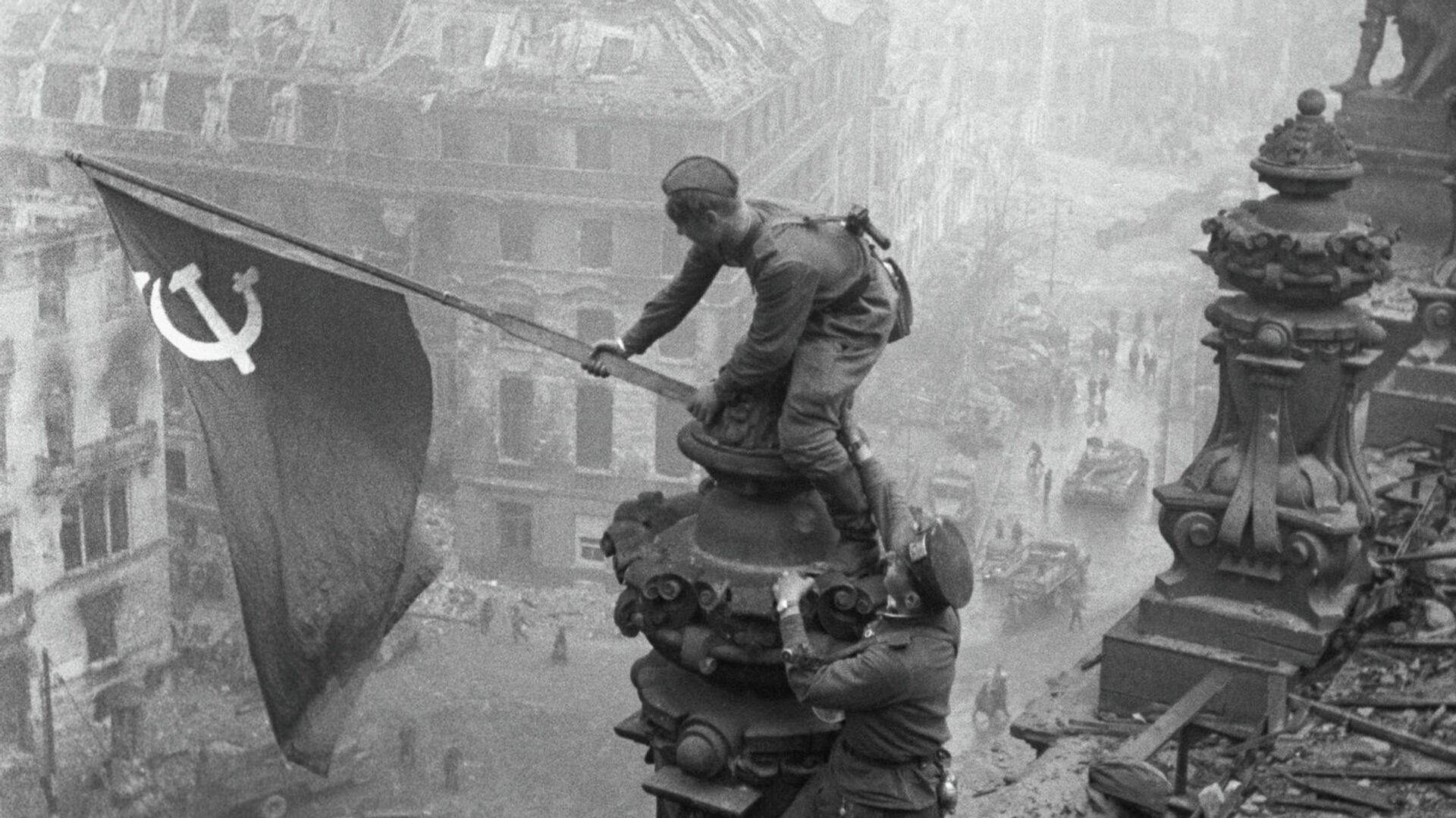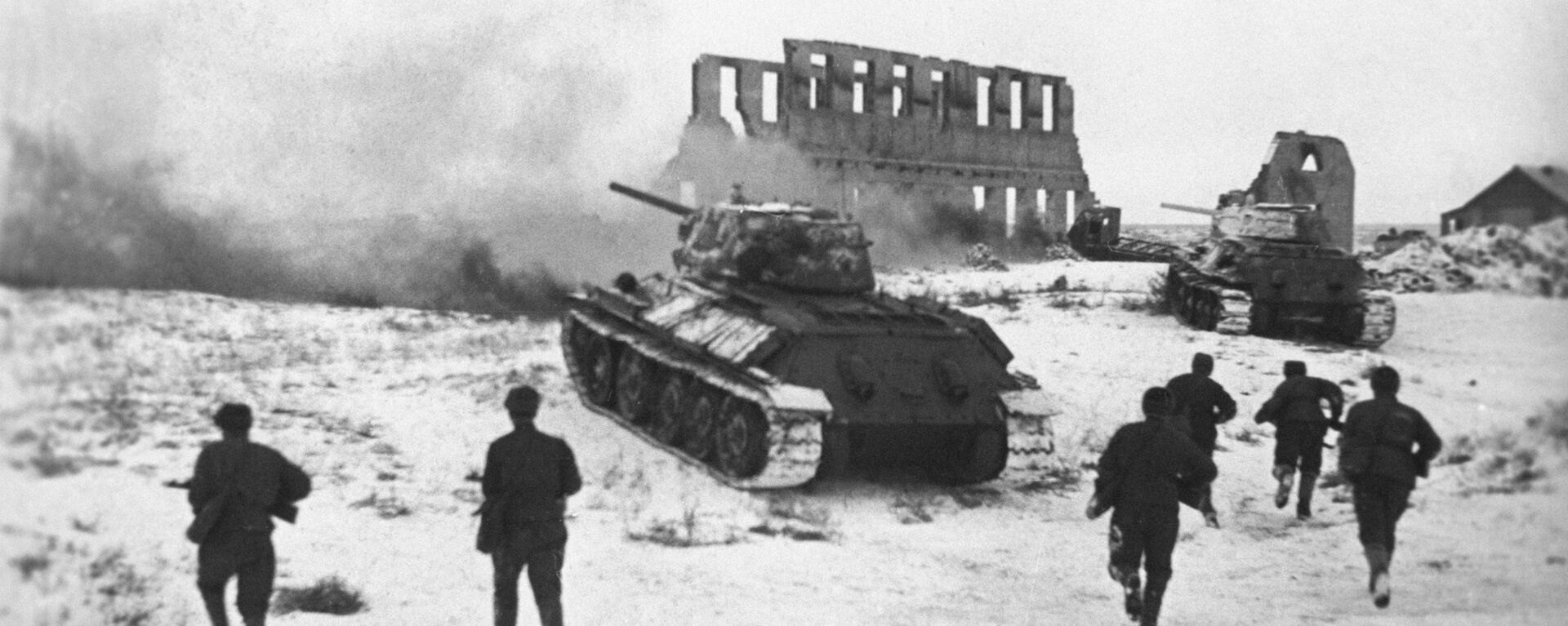https://sputnikglobe.com/20230501/may-1-the-day-the-red-army-hoisted-the-banner-that-heralded-third-reichs-fall-1110012346.html
May 1: The Day The Red Army Hoisted The Banner That Heralded Third Reich's Fall
May 1: The Day The Red Army Hoisted The Banner That Heralded Third Reich's Fall
Sputnik International
During the early hours of May 1, 1945, soldiers of the Soviet Red Army scored a symbolic victory against the Nazi German forces in Berlin, planting the Victory... 01.05.2023, Sputnik International
2023-05-01T16:28+0000
2023-05-01T16:28+0000
2023-05-01T16:39+0000
world war ii
berlin
reichstag
banner
red army
russia
https://cdn1.img.sputnikglobe.com/img/102146/20/1021462096_0:630:1401:1418_1920x0_80_0_0_b152d8963e27a9a893c78958aea83743.jpg
The banner was planted during the final stages of the battle for the German capital, with the Nazi troops surrendering shortly afterward. It also came not long after the infamous Nazi German dictator Adolf Hitler committed suicide to escape retribution at the hands of the Soviets.Storming the Reichstag was no mean feat, as by the time the Red Army troops launched their assault on April 29, the Nazis had turned the building, along with the other structures surrounding it, into a veritable fortress defended by elite SS troops.However, neither the skill nor determination of the Nazi forces who were ordered by Hitler to defend Berlin to the last would be enough to stop the Soviet soldiers who finally made their way to the very heart of their foe and were poised to deliver the final blow.The Red Army's attack on the Reichstag started on April 29, and on the afternoon of April 30, the Soviet soldiers finally managed to breach the building and bring the fight inside.Despite the fierce resistance offered by Nazi troops, the Red Army soldiers kept advancing, clearing the building room by room, and methodically wiping out the opposition.By the evening of April 30, the first Soviet red flag was installed upon the roof of the Reichstag building and a couple of hours later, the flag that became known as the Victory Banner – currently preserved in a special container at the Russian Central Armed Forces Museum in Moscow – was hoisted by Sergeant Mikhail Yegorov and Junior Sergeant Meliton Kantaria early on May 1.However, the fighting in the city did not stop immediately after the fall of the Reichstag. On May 2, Nazi German General Helmut Weidling, the last commander of the Nazi forces entrenched in Berlin, ordered his troops to surrender.Following the loss of their capital, many Nazi German troop units lost the will to fight and laid down their arms, and a few days later, what was left of the Nazi German leadership signed an unconditional surrender, with World War II in Europe finally drawing to a close.
https://sputnikglobe.com/20230407/more-americans-are-expressing-interest-in-soviet-world-war-ii-reenactment--reenactor-1109258422.html
berlin
Sputnik International
feedback@sputniknews.com
+74956456601
MIA „Rossiya Segodnya“
2023
News
en_EN
Sputnik International
feedback@sputniknews.com
+74956456601
MIA „Rossiya Segodnya“
Sputnik International
feedback@sputniknews.com
+74956456601
MIA „Rossiya Segodnya“
world war ii, battle of berlin, red banner over reichstag
world war ii, battle of berlin, red banner over reichstag
May 1: The Day The Red Army Hoisted The Banner That Heralded Third Reich's Fall
16:28 GMT 01.05.2023 (Updated: 16:39 GMT 01.05.2023) During the early hours of May 1, 1945, soldiers of the Soviet Red Army scored a symbolic victory against the Nazi German forces in Berlin, planting the Victory Banner on top of the Reichstag building.
The banner was planted during the final stages of the battle for the German capital, with the Nazi troops surrendering shortly afterward. It also came not long after the infamous Nazi German dictator Adolf Hitler committed suicide to escape retribution at the hands of the Soviets.
Storming the Reichstag was no mean feat, as by the time the Red Army troops launched their assault on April 29, the Nazis had turned the building, along with the other structures surrounding it, into a veritable fortress defended by elite SS troops.
However, neither the skill nor determination of the Nazi forces who were ordered by Hitler to defend Berlin to the last would be enough to stop the Soviet soldiers who finally made their way to the very heart of their foe and were poised to deliver the final blow.
The Red Army's attack on the Reichstag started on April 29, and on the afternoon of April 30, the Soviet soldiers finally managed to breach the building and bring the fight inside.
Despite the fierce resistance offered by Nazi troops, the Red Army soldiers kept advancing, clearing the building room by room, and methodically wiping out the opposition.
By the evening of April 30, the first Soviet red flag was installed upon the roof of the Reichstag building and a couple of hours later, the flag that became known as the Victory Banner – currently preserved in a special container at the Russian Central Armed Forces Museum in Moscow – was hoisted by Sergeant Mikhail Yegorov and Junior Sergeant Meliton Kantaria early on May 1.
However, the fighting in the city did not stop immediately after the fall of the Reichstag. On May 2, Nazi German General Helmut Weidling, the last commander of the Nazi forces entrenched in Berlin, ordered his troops to surrender.
Following the loss of their capital, many Nazi German troop units lost the will to fight and laid down their arms, and a few days later, what was left of the Nazi German leadership signed an unconditional surrender, with World War II in Europe finally drawing to a close.




